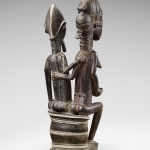
Back of the seated Baule couple from ivory Coast
Seated Baule couple, Ivory Coast
This superbe object is part of a very small corpus of only five known Baule statues of couple. Beside the one presented here, the most famous one is in the Barnes Foundation in Philadelphia, sold by Paul Guillaume in 1928. Another was in the Bottet collection in Nice, a third is at the Iowa Museum of Art, and the last belongs to a private collection.
What distinguishes this Baule couple is the manner in which the artist has carved differently the style of each face and the arms of one figure holding the back of the other. The head of the female figure is narrower, compressed and more elongated than the face of the male figure carved in a disc-shaped plane whereas the arms, legs and torsos of both male and female figures are modeled in a similar manner with a great feeling of tenderness induced by the gesture of arms holding the other partner by resting on their back. The feminine figure has this very elaborate coiffure with an amazing series of buns, whereas the male figure has this double twisted beard.
The elegant gesture of the arms holding each other in the back reminds us of some of the well-known statues in the arts of Ancient Egypt with the pharaoh and his wife already present during the Old kingdom Period (B.C. 2686-2181). As to the meaning of this extremely rare iconography of couples, one could probably look north towards a possible connection to Mande cultures with the series of Dogon seated couples from Mali such as the famous couple of the Barnes Foundation in Philadelphia. One can also admire seated couple among the Nok, which go back to 500 B.C., among the Ife culture, or more recently among the Urhobo in Nigeria.
As a final point, which is quite fascinating, the first image ever to be published of a Baule statue in situ, is based on the drawing by Louis Gustave Binger, a French explorer, who in 1887 drew a scene of a ritual with a witch-doctor dancing in front of a seated Baule figure, not a standing figure. So it shows how ancient that type of iconography is among Baule arts.
Publications
PUBLICATIONS
- Eberhard Fisher & Lorenz Homberger, Afrikanische Meister. Kunst der Elfenbeinküste, Museum Rietberg, Zurich, Schreidegger & Spiess, 2014, p. 85, illus. 90
- Eberhard Fisher & Lorenz Homberger, African Masters. Art from Ivory Coast, Museum Rietberg, 2014, p. 81, illus. 90
- Maria Baarspul, Maskers en beelden uit Ivoorkust. De Kunstenaars ontdekt, De Niewe Kerke, Amsterdam, 2014, p. 49, cat. 22
- Eberhard Fisher & Lorenz Homberger, Les Maîtres de la sculpture de Côte d’Ivoire, Paris, Musée du quai Branly, skira, 2015, p. 81, illus. 90
- Bernard de Grunne, Baule. Sedes possessio : seated Baule figures as thrones of the spirits, Bruxelles, 2016, p. 18, cat. 01
Photos ©F. Dehaen



